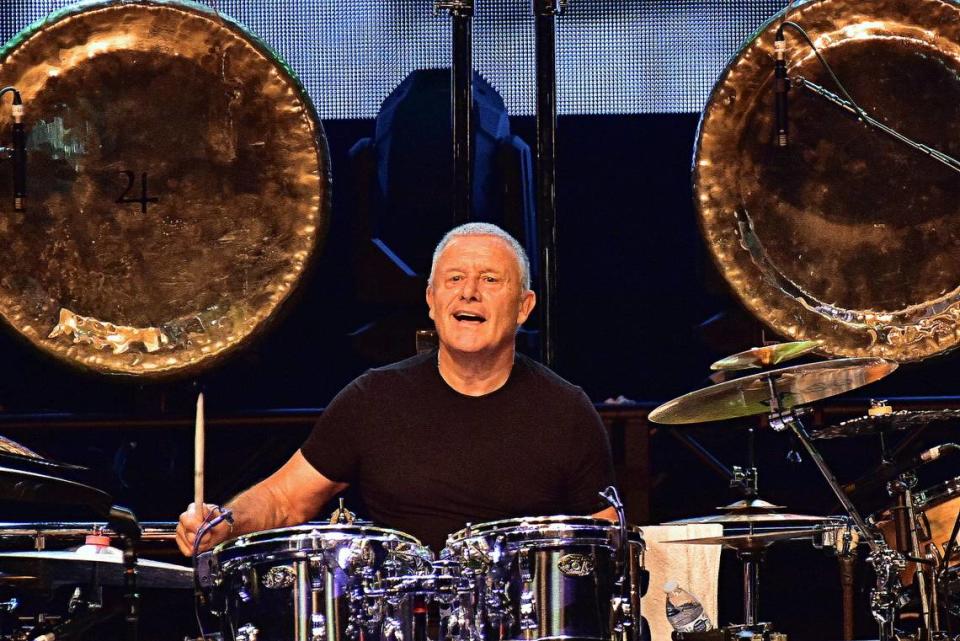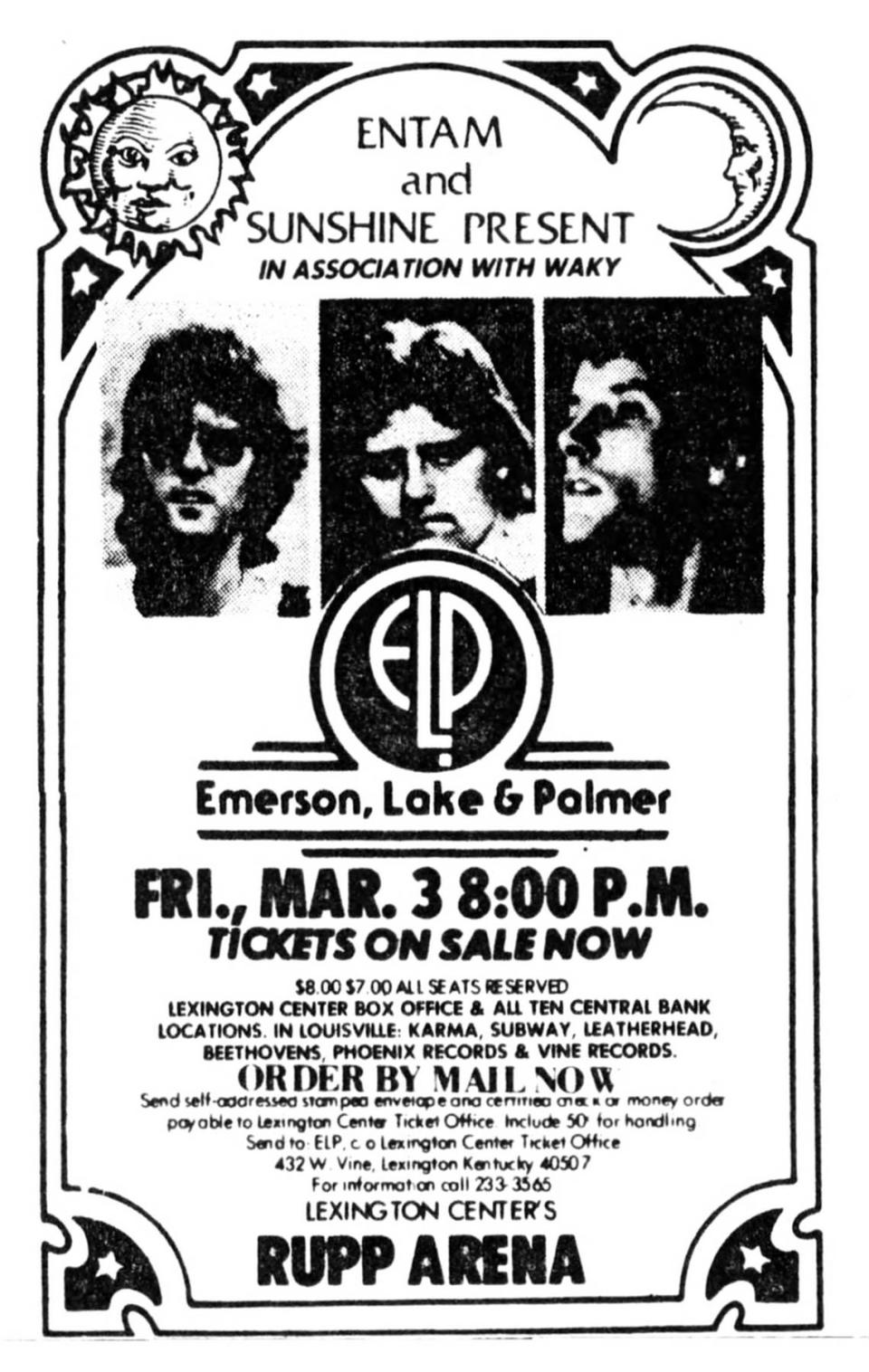Emerson, Lake & Palmer return to Lexington after 45+ years through digital magic
“Welcome back my friends to the show that never ends.”
That lyric, sung with the bravado of a carnival barker and backed by keyboard-drenched pageantry, sat at the heart of “Brain Salad Surgery,” the 1973 album by Emerson, Lake & Palmer that defined a prog rock movement at its commercial prime.
Those words also came to represent the trio’s performance vigor, from its ’70s heyday to its ’90s resurgence. It almost didn’t matter that Keith Emerson, Greg Lake and Carl Palmer spent the ’80s in splintered projects, disbanding seemingly forever in 2010. One sensed another reunion was always in the offing, that the show was indeed neverending. But with the deaths of keyboardist Emerson and bassist/guitarist/vocalist Lake nine months apart in 2016, the saga finally concluded. Or did it?
Bringing ELP back to life
Turns out drummer Palmer wasn’t quite ready to lower the curtain on ELP. Over the past year, the trio’s lone surviving member has designed a performance that has him honoring his former band’s prog legacy with help from his late bandmates.

For a program titled “The Return of Emerson, Lake & Palmer,” the drummer is performing ELP music live against ’90s era concert footage of Emerson and Lake. The backbone of the show has Palmer performing with his current trio (one, interestingly enough, that does not include keyboards.) The featured segments, though, have ELP together again — sort of.
“The Return of Emerson, Lake & Palmer” will also mark the drummer’s first Lexington performance since ELP played at Rupp Arena in March 1978.
“Something like this hasn’t been attempted before,” Palmer said. “The footage of Keith and Greg comes from (the DVD) ‘Emerson, Lake and Palmer Live at the Royal Albert Hall.’ It was done for Sanctuary (Records). Sanctuary sold out to Universal, so the DVD got released in the middle of that sellout. That’s why it was not super popular on a global level, which helps me now.

“What we have now is group-approved product, number one. Number two, it was a five-camera shoot. Number three, the audio lines for all of Keith’s keyboards, all of the vocals, all of Greg’s guitars and my drums were on separate tracks. This meant if I wanted to remix that album again, I could. Or if I wanted to use it in a live situation and play those tracks but remove the drums so I could actually play with them again, that could happen. And that’s exactly what we’re doing.”
Such a production called on some clever editing. Specifically, it required Palmer to slice himself out of the ’90s footage so that his live performances on each show of his current tour could be inserted and then mixed together in the same manner as a regular concert.
“There is a timeline involved with all the cameras we were using, so when Greg starts singing, he’s perfectly in time with me and with Keith. Everything can then be mixed for that theatre or that room we’re playing in that night. I play my drums live, then we push a button and all of those channels come up. They’re all automated, along with the visuals. Everyone is playing as if the band was still alive again.”
How ELP came together
ELP came together in London at the dawn of the 1970s, its three members all veterans of established bands — Emerson from The Nice, Lake from King Crimson and Palmer from Atomic Rooster. The tag quickly affixed to their music was prog, short for progressive rock. What that translated into was material heavy on complex instrumentation led by Emerson’s playing on piano, organ and what was then early experimentation on synthesizers. Lake’s vocals offered interludes of pop fancy while Palmer’s percussion work was inventive, intricate and often intensely physical. The bulk of the band’s popularity was built on a series of four studio albums released between 1970 and 1973 that culminated with “Brain Salad Surgery” along with a 1971 concert recording that reimagined Mussorgsky’s “Pictures at an Exhibition” for a rock audience.
“The United Kingdom gave the world prog rock,” Palmer said. “That’s where we came from. You (the United States) gave the world jazz and blues. But ELP was an eclectic band. We weren’t in one genre, like, say, Black Sabbath. We played lots of different types of music. Classical adaptations were very important to us. That stretched us musically and made us more interesting. There was more depth, so when people call us a prog rock band, I laugh in a way because all of the songs that opened the radio waves for us, like ‘Still You Turn Me On,’ ‘From the Beginning’ and ‘Lucky Man’ (all early ’70s singles) were short songs. But once people heard those songs years ago, they went deeper into the albums and discovered things like ‘Pictures at an Exhibition.’ They discovered ‘Tarkus’ (ELP’s sophomore album from 1971) and started to realize that this wasn’t just a prog band. This was a band that covered a lot of different genres. Prog just happened to be one we specialized in. But we had these pretty three-chord songs, so there was a bit of a bouncing backwards and forwards.”
Pulling off a live show with dead bandmates
While the tech-savvy reunion of ELP is the focus of Palmer’s current tour, his performances are anchored by the other members his long-running band — guitarist Paul Bielatowicz and bassist Simon Fitzpatrick.
“Paul and Simon, they duplicate the parts really well on guitars that the keyboards played on the ELP recordings, mainly through technology. We have a lot of synthesizer sounds can be triggered from the lead guitar similar to what Keith played and we’ll just follow some of those lines, some of those sounds. Simon plays a six-string bass guitar and the Chapman stick (a 10-stringed electric instrument), which he can also get synthesizer sounds from. Yes, it’s different from ELP, but it’s got a lot of the synthesizer sounds that people recognize from that period of time. It all works out remarkably well.”
There is another challenge in creating a semi-virtual ELP for the 21st century. Emerson and Lake were in their 40s at the time of the Royal Albert Hall performances utilized for the current performances. Palmer, the one playing live, will turn 74 in March. So how does that bode for summoning a level of physically demanding musicianship created when all three were in their 20s?
“A couple of things, really. I’ve always looked after myself, health-wise. I’ve never been a big drinker. I’ve never smoked cigarettes. Yeah, I’ve done a few drugs in the past when I was super young. But, in general, I haven’t led a rock ‘n’ roll life. But also, I enjoy what I’m doing immensely. I still practice five days a week. Sometimes, it’s only for 45 minutes, but I always practice. And I still love to play. I don’t like traveling as much, I will say that. But it’s just the interest of the music. It’s the want of getting better as a player.
“I still think I’m improving. While I’m healthy and fit and physically able to do it, I just think I’ve just got to keep pushing the button and giving it a go. If technology is on my side like it is to where I can come up with an idea like this, I want to be part of it.
“I will have to stop one day, but who knows when? Right now, I’m ready to play. I’m really ready to play.”
“The Return of Emerson, Lake & Palmer”
When: Feb. 28, 7:30 p.m.
Where: Lexington Opera House, 401 W. Short
Tickets: $45-$80 through ticketmaster.com.
